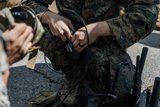DARPA HIVE programme continues
The Defense Advanced Research Projects Agency (DARPA) has selected Northrop Grumman to collaborate on the development of a graph processor chip that aims to enhance efficiencies and capabilities of today’s top processors.
As a part of DARPA’s Hierarchical Identify Verify Exploit (HIVE) programme, Northrop Grumman will work with five other entities to execute and evaluate real-time performance of various graph algorithms in a newly developed HIVE chip.
HIVE seeks to create and integrate technologies that will lead to the development of a generic graph processor, responsible for quickly analysing large data sets to determine correlations and dependencies that were unable to be discovered before.
Northrop Grumman will assess the possibility for graph analytics to resolve Department of Defense (DoD) processing challenges while also understanding how the analytics are currently used in DoD systems.
The problem facing today’s top processors is that there are currently few programming models and generalized processor architectures that can effectively support the irregular memory accesses and fine grained concurrency requirements of static and dynamic/streaming graph analytics, while also providing accelerated run-time support. The ability to quickly identify commonalities, patterns and dependencies in order to predict outcomes is vital due to the high volume and variety of data being generated every day.
The HIVE programme will address three key technical areas including: graph analytic processors, graph analytics toolkits and system evaluation.Northrop Grumman will identify and develop static and streaming graph analytics to solve five types of problem areas including: anomaly detection, domain specific search, dependency mapping, N-x contingency analysis and causal modelling of events.
This programme will look to identify new uses for graph analytics that have not been included in previous research due to processing, power or size constraints.
More from Digital Battlespace
-
![EID to unveil new vehicle communication system at DSEI]()
EID to unveil new vehicle communication system at DSEI
The Portuguese company’s naval communications system is in service across more than a dozen countries. It has turned to its home nation for support in developing a new vehicle based C2 system.
-
![Chess Dynamics successfully demonstrates Vision4ce AI-driven tracker]()
Chess Dynamics successfully demonstrates Vision4ce AI-driven tracker
The Vision4ce Deep Embedded Feature Tracking (DEFT) technology software is designed to process video and images by blending traditional computer vision with artificial intelligence (AI) algorithms to present actionable information from complex environments.
-
![Wave Relay devices cleared for security use on commercial systems in industry trend]()
Wave Relay devices cleared for security use on commercial systems in industry trend
Persistent Systems has been cleared by National Security Agency (NSA) to transmit sensitive data on commercial networks. The devices are added to the NSA’s Commercial Solutions for Classified (CSfC) component list which also includes other companies’ products providing the same security.
-
![UK teases cyber spending boost in Strategic Defence Review ahead of “imminent” release]()
UK teases cyber spending boost in Strategic Defence Review ahead of “imminent” release
The release of the UK’s Strategic Defence Review (SDR) has been long promised as mid-year. It is possible it could be as early as 2 June although the UK Ministry of Defence (MoD) continues to play its cards close to its chest.
-
![Intelsat emphasises SATCOM resilience for SOF in contested domains (video)]()
Intelsat emphasises SATCOM resilience for SOF in contested domains (video)
Intelsat outlines how its multi-orbit SATCOM architecture is enhancing connectivity and resilience for special operations forces operating in degraded and contested environments.
-
![US Space Force’s next-generation missile warning system moves forward with $500 million in new contracts]()
US Space Force’s next-generation missile warning system moves forward with $500 million in new contracts
Next-Generation Overhead Persistent Infrared (Next-Gen OPIR) satellites are intended to provide early warning of missile launches from any location worldwide and new ground stations will result in expanded coverage of critical missile warning.























